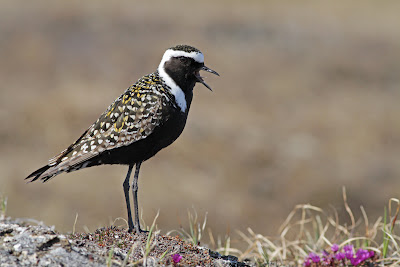Light clouds over camp at 10pm
Not too much today on this first
day of summer, went out banding/searching with Scott for the daily work. Mostly
today was just one of those days, luckily rare, where nothing goes right. I
accidentally deleted a photo on my camera I wanted to keep, only found one
nest, and was repeatedly stymied by difficult birds.
Three bears today however, but only
300 caribou. Weather was chillier again, but still clear and beautiful, been
like that for almost two weeks now! More Long-tailed Jaegers every day, and
zero Pomarine Jaegers for the first time, sure signs of the changing season. I
am now up to 63 species for the camp here in 20 days, adding Whimbrel and
White-winged Scoter today.
One of the consequences of the caribou is trampled nests - this egg was found near a nest that had had the other eggs crushed to a mess of yolk and shell
I did also develop a new skill
today – that of bleeding birds. Bleeding is performed by pricking the bird on
the underside of the wing with a needle where a vein crosses over the bone. You
make a very small pinprick that will only bleed a very small amount, and use a
capillary tube to collect the blood, which will be used for testing for DNA
analysis and avian malaria. A good skill to have in the arsenal!
May as well be the solstice again
today, since it is 24 hour daylight again! Doesn’t quite have as much meaning
up here..
Most intense parenting award goes to this Parasitic Jaeger - in this photo you can see the jaeger's wing THROUGH the wing of the Snowy Owl that flew too close to it's nest today. Talk about dedication.




















































